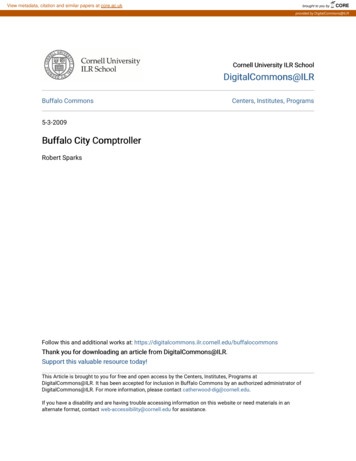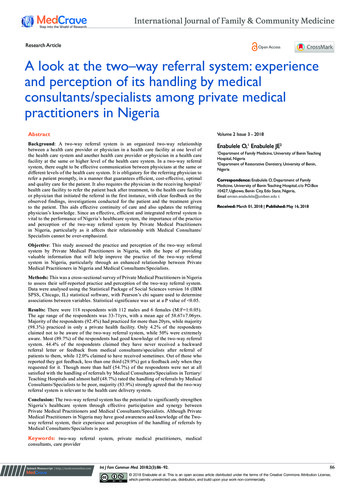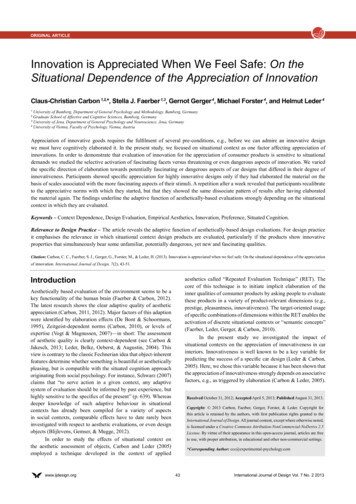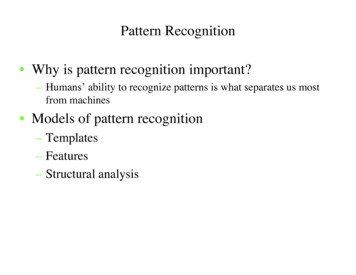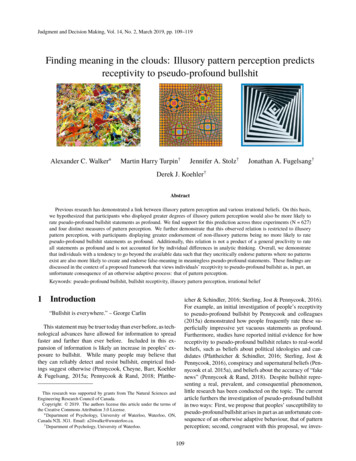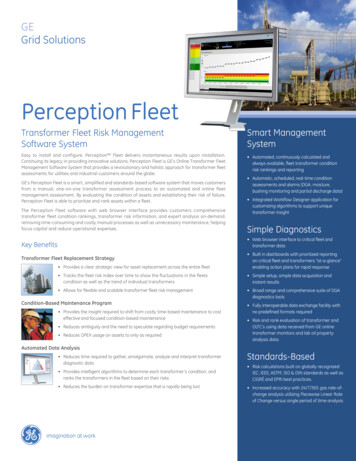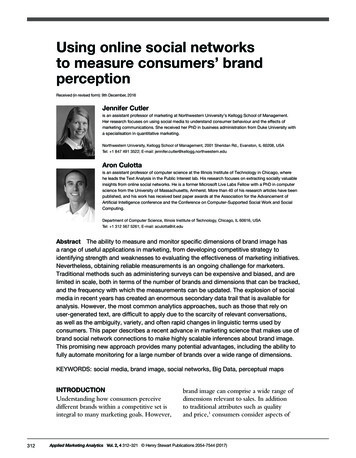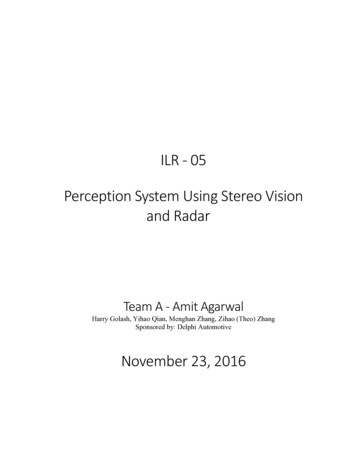
Transcription
ILR - 05Perception System Using Stereo Visionand RadarTeam A - Amit AgarwalHarry Golash, Yihao Qian, Menghan Zhang, Zihao (Theo) ZhangSponsored by: Delphi AutomotiveNovember 23, 2016
Table of Contents1. Individual Progress1.1 Delphi ESR 2.52. Challenges2.1 Data Understanding3. Teamwork4. Future Plans5. References . . . . . . .1144455
1. Individual ProgressSince the previous progress review, I was tasked with working on the Radar and getting a moremeaningful data visualization and gain further understanding of the messages from the Radar. Forthis I acquired PolySync software and worked with Zihao on getting a visualization on hiscomputer. In addition, I did a detailed study of the literature about the Delphi ESR 2.5 providedby PolySync.1.1 Delphi ESR 2.5Over the past couple of weeks, Zihao and I had been working on getting sensible data from theDelphi ESR 2.5 Radar. After multiple challenges to obtain data from the Radar, PolySync provideda very reliable and simple method of visualizing and obtaining data. PolySync is an advancedmiddleware platform designed to help engineers build, test and deploy safe driverless vehicleapplications quickly. A visual stream of real time data was obtained through the software. Aftersome initial testing was conducted in basement of the Newell Simon Hall, the Delphi ESR 2.5 wasmounted on the test car for further testing on the road. The test car used was a 2004 Volvo S602.5T AWD acquired by Harry. The Delphi ESR 2.5 was mounted in front of the grill of the testcar. This was done using multiple zip-ties. The zip-ties were perfect for an initial round of testingas they were easy to fix to the curved and ribbed structure of the front grill without any surfacestudy needed. The radar was inspected for how it responds to the forces experienced due to beingat the front of the test car. It was determined to be quite robust to such forces. Once the DelphiESR 2.5 was mounted, multiple routes of wiring were tested for the CAN and power connectionswith the Radar. Finally, wires were routed through the grill, under the hood, through the frontpassenger window into the car. The voltage generator was connected to the cigarette lighter socketusing a power inverter with an AC output. The AC power was routed into a multi socket surgeprotector. Since the testing conducted was for the whole team, multiple power outlets were usedto power the cameras, the radar, and the laptops connected to them. DC power was taken from theinverter using another adapter which provided 24 V as required for the Radar. The CAN outlet wasconnected to the laptop using a Kvaser Leaf Light v2. The first round of testing was performedovernight in Pittsburgh on roads near the campus for over 30 miles for at speeds from 20-30 milesper hour. Data was visualized on the PolySync Viewer using the PolySync Dynamic Driver. Inaddition, a simultaneous video of the road was taken so that visual inspection of the data can beperformed later in the lab. A detailed inspection of the data while driving and after driving madeway for understanding the tracking points that were obtained from the radar in the visualization.Another round of testing was then conducted to save the data obtained for this iteration. In thisiteration, the car was run around 20 miles at speeds from 15-30 miles per hour around the campus,and the data was recorded twice for five minutes each. This data was brought back to the lab forfurther evaluation.1
Figure 1. Radar Visualization InterfaceThe visualization was played and data values were inspected through the logging feature ofPolySync. A variety of different data is provided in addition to just the location of the visualizationfor a running stream of data. The tables were inspected and even though it was easy to understanda couple of the data fields, a lot of data fields which changed in value over time contained importantinformation. I conducted a literature study of the documentation available through PolySync. Afterreading multiple pages on the Publisher/Subscriber architecture, the Radar CAN documentation, Ifound the API documentation for PolySync. The documentation contained the description of theC class of the radar messages received by the name of ps radar track stream msg that wasobtained from the radar. This contained a description of the fields inside the message class,2
specifically the position[0], position[1], rangeType, rangeRate and trackStatus which helpeddescribe the visualized points much easier. Figure 1 shows an example of the screen visualizationobtained using PolySync with the data for that instant displayed in the table below thevisualization. The data was better understood using the table like the one shown below in Table 1,obtained from the API documentation from PolySync.TrackStatus0TRACK STATUS INVALIDTrack status information is invalid.1TRACK STATUS UNKNOWNTrack status information is unknown.2TRACK STATUS NOT AVAILABLEStatus information on the track is not available.3TRACK STATUS NO TRACKTrack is not valid and should not be considered usable.4TRACK STATUS RAW TARGETTrack is a raw target measurement and is not tracked.5TRACK STATUS ACTIVETrack is active/valid.6TRACK STATUS CIPVTrack is flagged as the closest in path vehicle.7TRACK STATUS NEWTrack is new to the tracker, ie the start of a track.8TRACK STATUS NEW UPDATEDTrack is new and was updated.9TRACK STATUS UPDATEDTrack was updated.10 TRACK STATUS COASTEDTrack was coasted.11 TRACK STATUS MERGEDTrack was merged.12 TRACK STATUS INVALID COASTED Track is invalid and was coasted.13 TRACK STATUS NEW COASTEDTrack is new and was coasted.14 TRACK STATUS KIND COUNTNumber of ps track status kind values.Table 1. TrackStatus detailsAfter understanding the data well, a proper understanding of the axes on which the data wasbased was understood. The axes are shown with respect to the car in Figure 2 below assuming theRadar is mounted on the front of the car with the right side of the Radar mounted facing up. Usingthis the data was understood further and inferences were made about the tracks obtained from theRadar.3
Figure 2. Data axes2. ChallengesThe major challenges faced were due to the message data provided by the Delphi ESR 2.5being hard to parse and hard to understand. In addition, the API documentation was hard to locate.2.1 Data UnderstandingObtaining the data apart from the visualization was not hard but learning how to do that was alittle challenging due to the platform being new to me. Once the data was recorded and saved, thenames of the fields in the Message class were not enough to properly describe the meaning of thedata. There is no direct link to the API documentation of the ps radar track stream msg class.This was found after sending PolySync an email which gave a link to a page of the PolySynccommunity forum answer, which had a link to the documentation. Apart from this, intuitivelyunderstanding the data was hard due to noisy nature of the data obtained from the Delphi ESR 2.5.3. TeamworkThe work this week was performed well by all 5 team members. Zihao and I worked on theRadar and getting sensible data from it which can be visualized. After obtaining this data, weworked on obtaining and understanding the data provided by the Radar in quantifiable numbers. Iwas majorly responsible for finding and comprehending the required the API documentation,resources and instruction manuals while Zihao ran the Linux system on his laptop and was workingwith the command line interface. Yihao and Menghan worked on the Object Detection algorithmsand literature study. In addition to that, they implemented and tested the stereo vision algorithmsfor a baseline of 1 m. Harry handled the prototyping of the mounting structure of the Radar and4
obtaining a GUI for visualizing the stereo image data. Harry and Zihao together worked ondeveloping the Radar mounting CAD for 3D printing. All members worked well and in a timelymanner.4. Future PlansIn the future, we plan to fabricate the final mounting structure for the Radar, and calibrate thebaseline for 60 m target distance for stereo vision with the updated mounting structure for thecameras. I will be working on setting up the Radar to collect the data in sync with the Camerasand prepare the team for the FVE presentation.5. References[1] "Delphi ESR 2.5". PolySync Support Center. N.p., 2016. Web. 12 Nov. 2016.5
connected to the laptop using a Kvaser Leaf Light v2. The first round of testing was performed overnight in Pittsburgh on roads near the campus for over 30 miles for at speeds from 20-30 miles per hour. Data was visualized on the PolySync Viewer using the PolySync Dynamic Driver. In

